comma คือ: คุณกำลังดูกระทู้
Table of Contents
Relative Clause คืออะไร?
สวัสดีค่ะนักเรียนม. 3 ที่รักทุกคน วันนี้เราจะไปดู Relative clause หรือ อนุประโยคในภาษาอังกฤษ ที่ทำหน้าที่เหมือนกันกับคำคุณศัพท์ (Adjective) ซึ่งมีหน้าที่ขยายคำนามที่อยู่ข้างหน้า และจะใช้ตามหลัง Relative Pronoun เช่น who, whom, which, that, และ whose แต่สงสัยมั้ยคะว่าทำไมต้องเรียนเรื่องนี้ ลองดูตัวอย่างประโยคด้านล่างแล้วจะร้องอ๋อ

ตัวอย่างประโยค
A girl is talking to Daniel. Do you know the girl?
ผู้หญิงกำลังคุยกับแดเนียล คุณรู้จักผู้หญิงมั้ย หากถามแบบนี้จะดูยาวและทะแม่งๆ ไม่คุ้นหูฝรั่งสักเท่าไหร่ โดยปกติเวลาเราจะเปลี่ยนประโยค 2 ประโยคให้เป็น Relative Clause โดยการดึงเอาส่วนที่เป็นประโยคหลักมาก่อนในที่นี้ก็คือ เราอยากรู้ว่าผู้ชายคือใคร คุณแดเนียลนั่นน่ะ
ขั้นตอนที่1 คือ แยกประโยคหลัก Do you know the girl? จากประโยคข้างต้น เราไม่มีทางรู้เลยว่าผู้หญิงที่พูดถึงเป็นใคร ดังนั้นเราจึงต้องใส่ข้อมูลเพิ่มเติม A girl is talking to Daniel. ใช้ A girl is talking to Daniel. เฉพาะในส่วนประโยคแรก และในส่วนที่สองเราแทนที่ด้วย relative pronoun
(ใช้ who ในกรณีอ้างถึงบุคคล) ดังนั้นประโยคจะเปลี่ยนเป็น
” Do you know the girl who is talking to Daniel? “
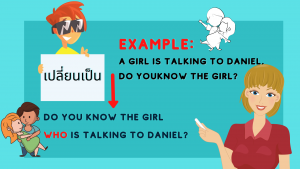
คุณรู้จักผู้หญิงที่กำลังคุยกับแดเนียลมั้ย เป็นอย่างไรกันบ้างคะ พอจะเห็นภาพของการใช้งาน Relative Clause แล้วใช่มั้ยคะ? อย่าพึ่งท้อนะคะ ไปลุยกันต่อกับประเภทของ Relative Clause เห็นข้อดีของการใช้ Relative pronoun หรือยังล่ะทีนี้ วันนี้ยังเหลืออีกเพียบไปดูกันเลยค่ะ
ประเภทของ Relative Clause
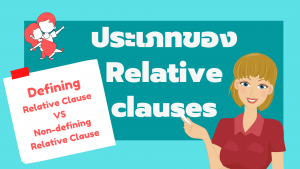
Relative Clause สามารถแบ่งออกได้เป็นสองประเภทคือ Defining Relative Clause และ Non-defining Relative Clause ขอเกริ่นก่อนว่าเราจะใช้ defining relative clause เพื่อบอกถึงสิ่งที่เรากำลังพูดถึง (หากขาดไปก็จะไม่สามารถรู้ได้เลยว่าพูดถึงอะไร)
เช่น I like the handsome man who sits next to me.
(ถ้าเราไม่บอกว่า “who sits next to me” ก็จะไม่ทราบเลยว่าหมายถึงผู้ชายคนไหน)
เราใช้ non-defining relative clause บอกถึงข้อมูลเพิ่มเติมของสิ่งที่เรากำลังพูดถึง (เราไม่จำเป็นต้องมีข้อมูลนี้เพื่อที่จะเข้าใจว่าพูดถึงอะไร) เช่น
I live in Thailand, which has beautiful tourist attractions.
(ประเทศไทยมีหลายสิ่งหลายอย่างน่าสนใจดังนั้น “which has beautiful tourist attractions.” ถือเป็นข้อมูลเพิ่มเติม จะมีหรือไม่มีก็ได้)
สรุปการใช้ Defining Relative Clauses
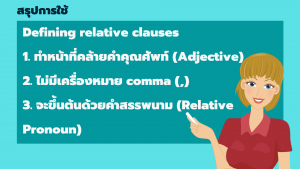
1. ทำหน้าที่คล้ายคำคุณศัพท์ (Adjective) เพื่อไปขยายนามที่อยู่ข้างหน้า ให้ได้ใจความสมบูรณ์และชัดเจนว่า หมายถึง ใคร สิ่งไหน หรือ ของใคร เป็นต้น
2. ไม่มีเครื่องหมาย comma (,) คั่นระหว่างนามกับ Defining Relative Clause
3. จะขึ้นต้นด้วยคำสรรพนาม (Relative Pronoun) ซึ่งจะต้องสอดคล้องกับนามที่ขยาย เช่น ถ้าขยายนามที่เป็นคน Relative Pronoun ก็ต้องเป็นคำที่ใช้แทนคน ฯลฯ
หน้าที่ของ Relative Pronoun จะมีหน้าที่อยู่ 3 ประการหลัก คือ
ทำหน้าที่เป็นประธาน มี 2 แบบ คือ
1.1 ถ้าเป็นคนใช้ who เช่น
I’m looking for a teacher who can teach me well.
ฉันกำลังมองหาครูที่สามารถสอนได้ดี
1.2 ถ้าเป็นสัตว์หรือสิ่งของใช้ which หรือ that เช่น
The mobile phone which / that is on the yellow shelf is mine.
มือถือที่วางอยู่บนชั้นวางของสีเหลืองเป็นของฉัน
- ทำหน้าที่เป็นกรรม มี 2 แบบ ได้แก่
2.1 ถ้าเป็นคนใช้ whom เช่น
The woman whom I talked to yesterday is Liza from Black Pink band.
ผู้หญิงที่ผมคุยด้วยเมื่อวานคือลิซ่าจากวงแบล็คพิงค์
2.2 ถ้าเป็นสัตว์หรือสิ่งของ ใช้ which หรือ that เช่น
I like the notebook that Jenny used yesterday.
ฉันชอบสมุดจดบันทึกที่เจนนี่ใช้เมื่อวานนี้
- 3. ทำหน้าที่เป็น “เจ้าของ” มี 2 แบบ คือ
3.1 เป็นคน ใช้ whose เช่น
The beautiful girl whose wallet is made from leather is Angelina.
ผู้หญิงคนสวยที่ถือกระเป๋าหนังใบนั้นชื่อแองเจลลิน่า
3.2 หากเป็นสัตว์หรือ สิ่งของให้ใช้ of which เช่น
The motorbike of which hand-break is broken has already been fixed last week.
รถมอเตอร์ไซค์คันที่เบรกมันเสียถูกซ่อมแล้วนะตั้งแต่อาทิตย์ก่อน
การใช้ Non-defining Relative Clauses
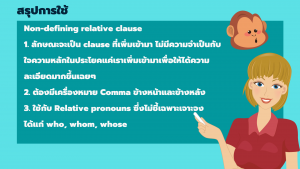
เป็นอย่างไรกันบ้างคะทุกคนสำหรับการใช้ Defining relative clauses ซึ่งจะต่างจาก Non-defining relative Clause ลองไปดูลักษณะที่สำคัญ อยู่ 3 ประการกันค่ะ
1. ลักษณะจะเป็น clause ที่เพิ่มเข้ามา ไม่มีความจำเป็นกับใจความหลักในประโยคแค่เราเพิ่มเข้ามาเพื่อให้ได้ความละเอียดมากขึ้นเฉยๆ
2. ต้องมีเครื่องหมาย Comma ข้างหน้าและข้างหลัง clause เสมอนะคะ ย้ำว่าเสมอ
3. ใช้กับ Relative pronouns ซึ่งไม่ชี้เฉพาะเจาะจง ได้แก่ who, whom, whose หรือ which เท่านั้น จะใช้ that ไม่ได้เลย
ตัวอย่างเช่น
My boyfriend, who is very handsome, lives in Korea.
แฟนของฉัน คนที่หล่อๆนั่นน่ะ อยู่ที่เกาหลี
Relative pronouns:
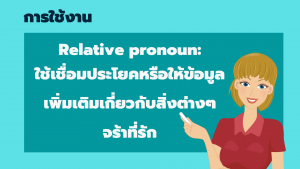
Relative pronoun ได้แก่คำว่า who, whom, whose, which, that, where, when, why เราจะใช้ relative pronoun ในการเชื่อมประโยคหรือให้ข้อมูลเพิ่มเติมเกี่ยวกับสิ่งใดๆ
ถาม: ถ้าตัด relative clause ทิ้งไป แล้วประโยคหลักไม่ได้มีใจความสำคัญเปลี่ยนไปมั้ยคะ
ตอบ: ไม่จำเป็นค่ะ เราจะใช้คอมม่าคั่นระหว่าง relative clause กับประโยคหลักแค่นั้น
Relative pronoun ส่วนใหญ่จะเป็นได้ทั้งประธานและกรรม ยกเว้น whom ที่จะเป็นได้แค่กรรมเท่านั้นนะคะ ส่วนการใช้ relative pronoun เป็นกรรม เราสามารถละ relative pronoun ได้ เช่น The person (who/whom/that) I met yesterday is Tim.
ถามอีก: การใช้ relative pronoun แทนสิ่งต่างๆ จะมีข้อกำหนดว่าเราจะใช้ตัวไหนแทนสิ่งใดได้กันบ้างล่ะ
ตอบ: ใช้กับสิ่งต่างๆเหล่านี้ค่ะ
คน – who, whom (กรรม), whose, that
สัตว์ – who (สัตว์เลี้ยง), whose, which, that
สิ่งของ, สิ่งไม่มีชีวิต, สิ่งที่เป็นนามธรรม – whose, which, that
ถาม: แล้วการใช้ Where, when, why
ตอบ: เราจะใช้ where แทนสถานที่ ใช้ when แทนเวลา และใช้ why แทนเหตุผล
เมื่อใช้เชื่อม relative pronoun เป็นกรรม การใช้ preposition ใน relative clause กับ whose และ which นั้นเราสามารถนำ preposition มาไว้ข้างหน้า whose กับ which ได้ แต่ส่วนใหญ่เราจะเจอในการเขียนที่เป็นทางการ academic writing และเมื่อใช้ whom การใช้ preposition ใน relative clause เราจะนำ preposition มาไว้ข้างหน้า whom
ตัวอย่างและรูปแบบการใช้งาน Relative Adverbs

Relative adverb คือคำกริยาวิเศษณ์ที่ทำหน้าที่เชื่อมคำ กับอนุประโยค หรือ ประโยครองเพื่อขยายความเพิ่มเติมให้รู้ว่า เมื่อไหร่ ที่ไหน ทำไม ซึ่งมีอยู่ด้วยกัน 3 คำ ได้แก่ when where และ why
1) Relative Adverb ที่ใช้แทนสถานที่
where ใช้เป็นกรรมของประโยค แปลว่า สถานที่ซึ่ง ที่
The house where adopted children live is very far.
บ้านหลังที่เด็กกำพร้าอาศัยอยู่ อยู่ไกลมาก
2) Relative Adverb ที่ใช้แทนเวลา
when ใช้เป็นกรรมของประโยค แปลว่า ที่
The time when I was ten years old, my mother passed away.
ตอนที่ฉันอายุได้สิบขวบ แม่ก็ได้จากไปแล้ว
3) Relative Adverb ที่ใช้แทนเหตุผล
why ใช้เป็นกรรมของประโยค แปลว่า ที่
I have no idea why Tina dumped Adwerd.
ฉันไม่รู้เหตุผลที่ตีน่าทิ้งแอดเวิร์ดเลย
เป็นยังไงกันบ้างคะอย่าลืมฝึกเขียนกันเยอะๆนะคะ เพื่อที่เราจะได้ฝึกแต่ง Relative Clause ให้เจ๋งๆ ถ้าเกิดว่าเรายังไม่เข้าใจจุดไหนสามารถโพสต์ถามได้ที่ด้านล่างเลยนะคะ ครูยินดีตอบเสมอ อย่าลืมทบทวนบทเรียนผ่านวีดีโอด้านล่างเด้อ เลิฟๆ
+1
[NEW] 9 วิธีใช้คอมม่าในภาษาอังกฤษแบบเบื้องต้น เจอทุกข้อสอบแน่นอน! | comma คือ – NATAVIGUIDES
สวัสดีค่ะน้องๆ ชาว
Dek-D.com
วันนี้เรามาเรียนแกรมมาร์ง่ายๆ ตัวนึงที่เราคุ้นเคยกันมากๆ ดีกว่าค่ะ นั่นคือการใช้เครื่องหมายจุลภาคหรือคอมม่า (comma) นั่นเอง มาดูกันว่าวิธีใช้ขั้นพื้นฐานของคอมม่ามีอะไรกันบ้าง
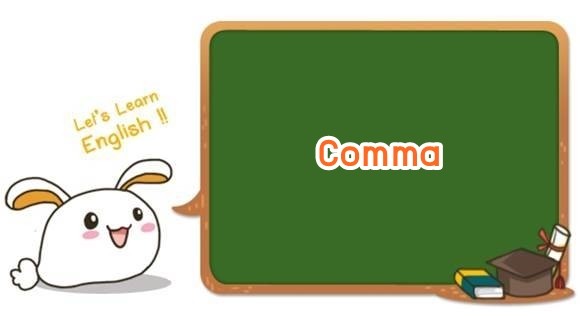
1. ใช้คั่นคำหรือกลุ่มคำที่เรียงต่อกันตั้งแต่ 3 อย่างขึ้นไปในความหมายว่า “และ” หรือ”หรือ”
เห็นชื่อแล้วอาจจะงงๆ ว่ามันใช้ยังไงนะ จริงๆ มันก็คือใช้คั่น cat, dog, bird, and rat นั่นแหละค่ะ แต่ทีนี้จะเป็น and หรือว่า or รั้งท้ายก็ได้ ที่สำคัญคือต้องมี 3 อย่างขึ้นไปจะ cat, dog เฉยๆ ไม่ได้ ถ้ามีแค่ 2 ก็ใช้ cat and dog ได้เลย
อีกเรื่องที่น่าสนใจคือ บางคนจะเขียนคอมม่าไว้หน้า and หรือว่า or แต่บางคนก็ไม่เขียนเช่น
I have 2 cats, 3 dogs, and 5 birds.
กับ
I have 2 cats, 3 dogs and 5 birds.
ซึ่งถือว่าถูกทั้งคู่ค่ะ จะใช้แบบมีคอมม่าตัวสุดท้ายหรือไม่ก็ได้ แต่พี่อยากให้ใช้แบบมีมากกว่าค่ะ ส่วนสาเหตุที่อยากให้ใช้ก็คือมันช่วยให้สับสนน้อยลงได้เมื่อเจอกลุ่มคำก้อนใหญ่ขึ้นมา เช่น
I have coffee, hot chocolate and milk and tea.
ถ้าเจอแค่นี้ เราแปลความได้หลายอย่างค่ะ
– มีของ 4 อย่าง 1) กาแฟ 2) ช็อคโกแลตร้อน 3) นม 4) ชา
– มีของ 3 อย่าง 1) กาแฟ 2) ช็อคโกแลตร้อน 3) นมกับชา
– มีของ 3 อย่าง 1) กาแฟ 2) ช็อคโกแลตร้อนกับนม 3) ชา
ทีนี้ก็จะงงได้ว่าตกลงเมนูไหนที่เป็นของผสมกันแน่ ดังนั้นการใส่คอมม่าไปช่วยก็จะทำให้เราเข้าใจว่ามันคือ
I have coffee, hot chocolate and milk, and tea.
มี 3 อย่างนะ 1) กาแฟ 2) ช็อคโกแลตร้อนกับนม 3) ชา ซึ่งเจ้าคอมม่าตัวสุดท้ายนี้มีชื่อว่า Oxford comma ค่ะ มันมีประโยชน์ในหลายสถานการณ์จริงๆ นะ ยิ่งถ้าเขียนเรียงความก็ควรใส่ทุกครั้ง เพราะจะช่วยให้คนอ่านเข้าใจงานเขียนของเราได้ง่ายขึ้นค่ะ
นอกจากคั่นคำและกลุ่มคำแล้ว จะคั่นการกระทำก็ได้เช่นกัน เช่น
I had dinner, washed the dishes, and went to bed.
ฉันกินอาหารเย็น ล้างจาน และขึ้นนอน ก็ใช้คั่นได้เช่นกัน
2. ใช้คั่นประโยคเมื่อใช้คำเชื่อมจิ๋วๆ มาเชื่อมให้เป็นประโยคความรวม
คำเชื่อมจิ๋วๆ ก็คือพวก
and, or, but, for, nor, yet, so
ที่เป็นคำสั้นๆ นี่แหละค่ะ เวลาเชียนเราก็จะใส่คอมม่าหลังจบประโยคแรก เช่น
I really want to go to school, but I am too sick to go.
ฉันอยากไปโรงเรียนจริงๆ แต่ฉันป่วยเกินจะไปได้ แต่ถ้าเป็นประโยคที่สั้นมากๆ อย่าง I come and you go. ก็สามารถละคอมม่าได้ค่ะ
นอกจากนี้ถ้าประโยคหลังไม่มีประธาน ก็สามารถละคอมม่าได้เช่นกัน เช่น I thought for a while but still did not answer correctly. (ฉันคิดเป็นระยะเวลาหนึ่งแต่ก็ตอบไม่ถูกอยู่ดี) ประโยคนี้เราละประธานของ did not answer เพราะประธานคือ I เหมือนประโยคหน้า จึงสามารถละคอมม่าได้ค่ะ แต่ก็นั่นแหละ มันต้องมีบางประโยคที่ละแล้วทำให้สับสนยิ่งกว่าช็อคโกแลตร้อนอยู่แน่ๆ อย่างเช่นตัวอย่างนี้

I saw that he was busy and prepared to leave. ถ้าไม่มีคอมม่าแบบนี้ผู้อ่านจะตีความว่ามันคือ
I saw that he was busy. He was prepared to leave.
แต่ถ้าความหมายจริงๆ ที่เราต้องการคือ I saw that he was busy. I prepared to leave. แบบนี้ต้องมีคอมม่าเข้าไปช่วยทำให้กระจ่างค่ะ โดยเขียนเป็น
I saw that he was busy, and prepared to leave.
แบบนี้ผู้อ่านก็เข้าใจได้ว่าตัว I เป็นคน prepared เอง
3. ใช้คั่นเมื่อมีอนุประโยคนำหน้าในประโยค
ภาษาทางการดูยากอีกแล้ว อนุประโยคที่ใช้ขึ้นต้นประโยคก็เช่น V.ing หรือคำบุพบทหรืออะไรที่มันไม่ใช่ประธานกริยากรรมแบบธรรมดาทั่วไป ตัวอย่างเช่น
If you are not sure about this, let me know now.
(ถ้าคุณไม่แน่ใจก็บอกฉันมาเลย)
After his long nap in the backyard, he felt better.
(หลังงีบในสวนหลังบ้านเป็นเวลานาน เขาก็รู้สึกดีขึ้น)
นอกจากนี้พวกประโยคที่ขึ้นด้วย Adverb ก็ใช้คอมม่าตามหลังเพื่อคั่นเช่นกัน
Sadly, our old school was completely destroyed.
(น่าเศร้าที่โรงเรียนเก่าของเราถูกทำลายจนสิ้น)
เช่นเดียวกับวิธีใช้ข้ออื่นๆ ที่บอกไป ถ้าอนุประโยคข้างหน้าสั้นๆ เข้าใจง่าย เราจะไม่ใส่คอมม่าก็ได้ค่ะ แต่ต้องสังเกตดีๆ ด้วยว่าถ้าไม่ใส่แล้วจะทำให้ความหมายกำกวมมั้ย
เช่น Last Friday evening classes were canceled.
เวลาคือก้อนไหนระหว่าง Last Friday evening กับ Last Friday
Last Friday, evening classes were canceled.
(เมื่อวันศุกร์ที่แล้ว ชั้นเรียนตอนเย็นถูกยกเลิก)
Last Friday evening, classes were canceled.
(เมื่อเย็นวันศุกร์ที่แล้ว ชั้นเรียนถูกยกเลิก)
4. ใช้คอมม่าคร่อมส่วนขยายที่สามารถตัดทิ้งได้
ข้อนี้น่าจะคุ้นเคยกันดีอยู่แล้ว เพราะเจออยู่บ่อยๆ เช่น
My big sister, Rita, is coming.
ประโยคนี้เราสามารถตัดริต้าออกไปได้ ให้เหลือแค่ My big sister is coming. ก็เข้าใจได้อยู่
Jimmy, who is a president of this club, cannot be here today.
เราก็ตัดท่อนในคอมม่าออกไปได้เช่นกัน ความหมายยังเหมือนเดิมคือจิมมี่ไม่สามารถมาได้
5. ใช้คั่นชื่อที่ตั้งเมืองเช่น เมืองกับรัฐ หรือจังหวัดกับประเทศ หรือเมืองกับประเทศ
Bangkok, Thailand, is “The City of Angels.”
I went to London, England, last year.
ไม่ว่าจะเป็นชื่อถนน หมู่บ้าน ตำบล อำเภอ จังหวัด รัฐ แคว้น หรือประเทศ และไม่ว่าจะอยู่ต้าประโยค กลางประโยค หรือท้ายประโยคก็สามารถใช้คอมม่าคั่นได้ทุกตำแหน่งเลยค่ะ
6. ใช้คั่นเวลาเรียกใคร หรือเวลาอุทาน เช่น
Hello, sir.
I need your help, Lisa.
Yes, I did.
Well, it could be.
Let’s eat, Mom!
ลองนึกภาพเราไม่ใส่คอมม่าสิ ประโยคก็จะออกมาเป็น Let’s eat Mom! (กินแม่กันเถอะ)
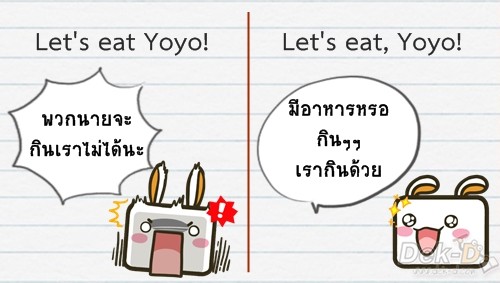
7. ใช้คั่นสิ่งที่อยู่ในเครื่องหมายคำพูดกับสิ่งที่อยู่ข้างนอก
อ่านแล้วต้องงงแน่ๆ ลองมาดูตัวอย่างแบบต่างๆ นะคะ
“I thought,” said Dan, “you were going out with him.”
“How could you,” she cried. “How could you do that to me?”
“I love you,” she said.
She said, “I love you.”
**อ่านเรื่องการใช้เครื่องหมายคำพูดเพิ่มเติมได้ที่
อ่านแล้วต้องงงแน่ๆ ลองมาดูตัวอย่างแบบต่างๆ นะคะ**อ่านเรื่องการใช้เครื่องหมายคำพูดเพิ่มเติมได้ที่ www.dek-d.com/studyabroad/37997/
8. ใช้คั่น question tag
I can go, can’t I?
(ฉันไปได้ใช่มั้ย)
That’s your book, isn’t it?
(นั่นคือหนังสือของคุณใช่มั้ย)
I am a student, aren’t I?
(ฉันเป็นนักเรียนใช่มั้ย)
9. ใช้คั่นวันที่กับปี
It was in the in that magazine’s August 5, 2015, edition.
(มันอยู่ในนิตยสารเล่มนั้นฉบับวันที่ 5 สิงหาคม 2015
แต่ถ้าไม่มีวันที่มาให้ มีแค่เดือนกับปีก็ไม่ต้องใส่คอมม่าค่ะ นี่ไม่ได้ให้เลือกว่าจะใส่หรือไม่ใส่ก็ได้นะคะ แต่กฎนี้คือห้ามใส่เลย เช่น It was in the in that magazine’s August 2015 edition.
ทั้งหมดนี้เป็นวิธีใช้คอมม่าแบบเบื้องต้นค่ะ จริงๆ ยังมีกฎอีกหลายข้อและรายละเอียดอีกมากมายแต่จะลึกเกินไป แม้อาจจะดูเหมือนกฎเยอะและจุกจิก แถมยังมีตัวที่ใส่ก็ได้ไม่ใส่ก็ได้ แต่ถ้าเจอแบบนั้นพี่แนะนำให้ใส่ไว้จะดีกว่าค่ะ เพราะมันช่วยชีวิตเราได้จริงๆ แถมยังช่วยชีวิตโยโย่ไว้ไม่ให้ถูกเรากินด้วย 555 แล้วพบกับ
English Issues
ได้ใหม่เสาร์หน้านะคะ
Comma story – Terisa Folaron
View full lesson: http://ed.ted.com/lessons/commastoryterisafolaron
It isn’t easy holding complex sentences together (just ask a conjunction or a subordinate), but the clever little comma can help lighten the load. But how to tell when help is really needed? Terisa Folaron offers some tricks of the comma trade.
Lesson by Terisa Folaron, animation by Brett Underhill.
นอกจากการดูบทความนี้แล้ว คุณยังสามารถดูข้อมูลที่เป็นประโยชน์อื่นๆ อีกมากมายที่เราให้ไว้ที่นี่: ดูความรู้เพิ่มเติมที่นี่

Grammar Lesson 23 1 Run ons, Comma Splices, and Fragments

15 Phrasal verbs to impress your IELTS examiner
😃 My online course FLUENCY for IELTS SPEAKING DISCOUNTED!
https://keithspeakingacademy.teachable.com/p/fluencyinenglish/
👉 My complete online course IELTS SPEAKING SUCCESS Get a Band 7+
https://keithspeakingacademy.teachable.com/p/ieltsspeakingsuccessgetaband7?src=YTREC
Thank you to Cambly for sponsoring this video:
Get a 15minute free lesson OR subscribe to any 12month plan with a 40% discount, with the code: keithyt.
Take a free lesson: http://bit.ly/keithmin
Get a 40% discount: http://bit.ly/keithdisc
Today I have got 15 phrasal verbs that will impress your IELTS examiner.
And if you are thinking “Great but Keith, what are phrasal verbs?” Then you really need to watch this!
Read the whole lesson here: https://keithspeakingacademy.com/15ieltsphrasalverbsspeakinglesson/
Topics covered in this video:
00:00:00 Welcome
00:01:14 How to learn phrasal verbs
00:03:52 What are phrasal verbs?
00:05:58 Idiomatic phrasal verbs
00:07:41 Favorite phrasal verbs 1 4
00:12:03 Word order
00:15:13 Favorite phrasal verbs 5 8
00:18:54 Pronunciation
00:21:08 Favorite phrasal verbs 9 15
👍 Get get a complete Mock IELTS Test with TakeIELTS.net
https://takeielts.net/thepathtosuccessintheieltstest/
Get a 10% discount with the CODE: keith10
🎁 Download my free ebook: AVOID 10 MOST COMMON MISTAKES IN IELTS SPEAKING:
https://keithspeakingacademy.com/
Follow me on social media
Facebook Page: https://www.facebook.com/keithspeakingacademy
Facebook Group: https://www.facebook.com/groups/KeithIELTSMastermind/
Website: https://keithspeakingacademy.com/
IELTSSPEAKING IELTSspeaking IELTSphrasalverbs IELTS2021 keithspeakingacademy
Keep practicing
Be patient
and improve!
Keith

IFOSS6E21 | How To Have A Good Public Speech?
Nhiều bạn khán giả thường đặt câu hỏi về cho chương trình là làm thế nào để có một bài diễn thuyết trước đám đông hay hiệu quả, làm sao để không còn cảm thấy run sợ nữa.
Hôm nay thầy Tommy sẽ giải đáp và có lời khuyên cho các bạn đây! Nhớ xem hết video nhé!
Xem bản FULL đầy đủ Eng\u0026Vie sub tại đây nha:
https://youtu.be/7TIqBHs5qoM
lastepisode publicspeech ifojunior khanhvy thaotam
Xem toàn bộ các chương trình của Đài Truyền hình Việt Nam tại VTVGO
https://vtvgo.vn
🔔IFO SS6 phiên bản Junior lên sóng vào 21H tối thứ 4 và thứ 7 hàng tuần trên VTV7
👉Đừng quên đồng hành và theo dõi chương trình với các clip exclusive trên kênh Youtube và các kênh social media khác của chương trình:
🔴 Fanpage: https://www.facebook.com/IELTSFACEOFF…
🔴 Instagram: @ieltsfaceoff
🔴 Kênh Youtube: https://www.youtube.com/c/8IELTS
🔴Tik Tok: https://vt.tiktok.com/jJf3Hu/
Hãy cùng IELTS FACEOFF chinh phục IELTS và những thử thách trên hành trình của bạn!

The Comma for Lists Song | Rap and Learn with MC Grammar
Play this song and rap along to learn all about commas, and how to use them in a list.
This song breaks down the process for you and provides you with some great examples and a ton of fun and cool dance moves. By learning the song you will never forget how to use a comma to create a list. You will also be able to use a colon to introduce a list and a semicolon in more complex lists too.
Follow the simple steps:
1. Play the song
2. Use the lyrics below or on the video to rap along
3. Learn!
For more free English lessons, subscribe to this channel: www.youtube.com/mcgrammartv
Age Range: 611yrs (Key Stage 1 and Key Stage 2)
Lyrics to rap along:
Chorus
Whenever I write a list,
I know that I must use this,
To separate what exists.
What is it?
Say it loud!
Do it now!
It is a comma!
Whenever I write a list,
I know that I must use this,
To separate what exists.
What is it?
Say it loud!
Do it now!
It is a comma!
Verse:
Let’s dance:
Stop,
Comma,
Left foot,
Comma,
Right Foot,
Comma,
Criss Cross,
Comma,
Jump back,
Comma,
Hands up,
Comma,
Turn around and finish how you wanna!
Go again:
Stop,
Comma,
Left foot,
Comma,
Right Foot,
Comma,
Criss Cross,
Comma,
Jump back,
Comma,
Hands up,
Comma,
Turn around and finish how you wanna!
Go again!
Chorus
Whenever I write a list,
I know that I must use this,
To separate what exists.
What is it?
Say it loud!
Do it now!
It is a comma!
Oh, and don’t forget to send YOUR grammar raps to [email protected].
Please make sure you ask your parent or guardian for their permission first.
Visit us on Facebook: www.facebook.com/mrmcgrammar
Follow us on Twitter, TikTok and Instagram: @mrmcgrammar

นอกจากการดูบทความนี้แล้ว คุณยังสามารถดูข้อมูลที่เป็นประโยชน์อื่นๆ อีกมากมายที่เราให้ไว้ที่นี่: ดูวิธีอื่นๆLEARN FOREIGN LANGUAGE
ขอบคุณมากสำหรับการดูหัวข้อโพสต์ comma คือ